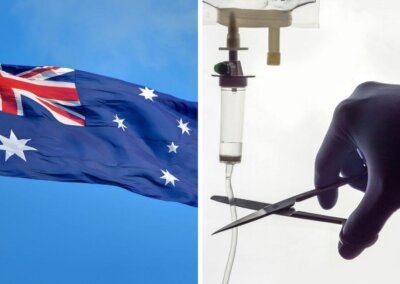The number of people who ended their lives by assisted suicide or euthanasia in Victoria, Australia, has increased 31% in a single year, reportedly accounting for 0.58% of all deaths in the state during that period.
In an annual Voluntary Assisted Dying Review Board Report of Operations, between July 2021 and June 2022 there were 231 instances of assisted suicide in Victoria and 38 instances of euthanasia. Since assisted suicide and euthanasia were made legal in 2019, a total of 604 people have taken one of these options to end their lives.
According to Australian Care Alliance: “Deaths by euthanasia and assistance to suicide in the twelve months July 2021 to June 2022 represent 0.58% of all deaths in Victoria for that period”.
The group points out that the state of Oregon, which has had assisted suicide since 1997, took 22 years before assisted suicide accounted for the same percentage of deaths overall.
Shortfall in palliative care funding
The chairman of the Voluntary Assisted Dying Review Board, Julian Gardner, said: “The number of people seeking to access voluntary assisted dying continues to increase… This is a further indicator of the success of the system”.
At present, the law forbids doctors from tele-consultation for assisted suicide so it cannot be done via electronic communication. Mr Gardner says that the board is attempting to change the law to remove such safeguards surrounding assisted suicide and euthanasia.
“The law as it exists creates barriers to access [assisted suicide and euthanasia]” he said. “A change to the law will [facilitate assisted suicide and euthanasia] for all Victorians, regardless of their location or mobility”.
At the same time, according to Palliative Care Victoria, “Demand for palliative care services has increased by 11.9% over the last 5 years, due to the growing and ageing of Victoria’s population. Meanwhile, funding increased by only 10.2% in the same period. The shortfall in funding for service delivery is expected to reach A$91.2 million by 2025.”
The Voluntary Assisted Dying Act 2017 permits assisted suicide and euthanasia in cases where a patient is physically unable to self-administer the lethal drugs. Patients must be mentally competent and suffering from a terminal illness with likely less than six months to live, or 12 months for neurodegenerative disorders.
Right To Life UK spokesperson Catherine Robinson said: “It seems that Mr Gardner has little idea about the functions of law. One of the functions is precisely to create barriers to protect the vulnerable. In the UK, the law forbids assisted suicide and euthanasia because, in part, it recognises the profound danger that such laws create for the sick and vulnerable. The law in the UK recognises that people in such conditions deserve the same protections as everybody else”.
“Mr Gardner, however, seems to think that people who are near the end of their life ought not be afforded the same protections as the rest of us, that their lives are not worth as much as the rest of our lives are. This is clear from the fact that only people who are ‘terminally ill’ can access assisted suicide or euthanasia. We all rightly recognise that it would be a tragedy if a healthy 25-year-old woman ended her life for whatever reason and we do everything we can to discourage suicide. Yet, Victoria has deemed that the lives of its most vulnerable citizens are not worthy of the same protection and have created law that actively encourages suicide for people who are terminally ill”.












